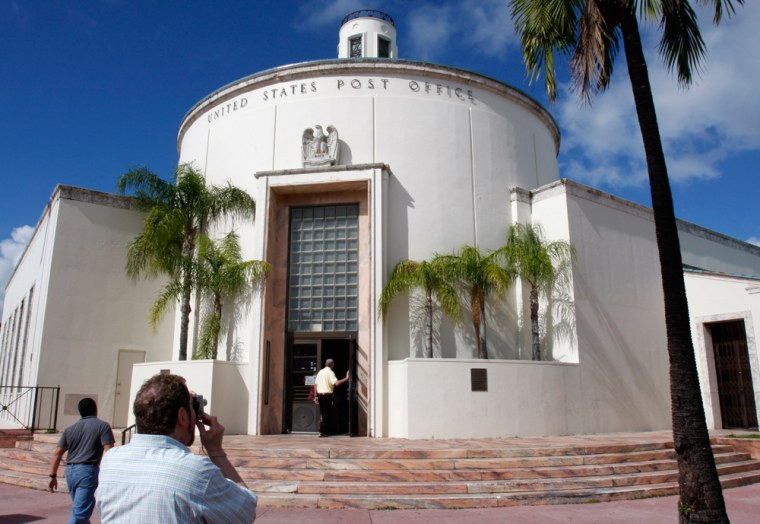Modern-day South Beach is still a vibrant monument to the Art Deco designs of the late 1920s and '30s.
The narrow streets are lined with hotels and buildings designed with curved edges, porthole windows and pastel-colored facades, all touchstones of the style.
The Miami Design Preservation League is offering tours of the Art Deco district — guided, recorded and one that can even be done listening on a cell phone.
On a recent sun-drenched morning, guide Erika Brigham, who has lived in the area since 1988, kicked off the tour with a lively talk about the architectural history of the neighborhood. She wore palm tree-shaped earrings, a gold-and-black speckled visor and a T-shirt promoting the annual weekend event celebrating Art Deco, which was scheduled this year for Jan. 18-20.
"I think it's incredibly important to preserve the buildings," Brigham said. "They have a much more human scale than skyscrapers."
One stop on the tour is the Amsterdam Palace at Ocean Drive and 11th Street. It is of Mediterranean Revival design, which features decorative columns, arched windows, clay barrel tile roofs and rough stucco walls. Today it's known as Casa Casuarina, a five-star luxury hotel. It is perhaps most famous for a bit of notoriety: Italian fashion designer Gianni Versace was gunned down outside in 1997.
Next up are three small hotels facing the ocean just north of the palatial villa. They are the Leslie, built in 1937; the Cardozo, constructed two years later; and the Carlyle, built in 1941. The Cardozo was named for one of the first Jewish justices on the U.S. Supreme Court, Benjamin Cardozo.
"People used a variety of names (for hotels). Sometimes it was a daughter or a wife or a mistress," said Scott Timm, director of programs and outreach for MDPL.
Brigham said the Carlyle was in the 1996 movie "The Birdcage," which starred Robin Williams, Gene Hackman and Nathan Lane. The owners refurbished it a bit for filming, but it has remained empty ever since, she said.
All three oceanfront hotels have the trademark Art Deco designs including horizontal banding and "eyebrows," which are cantilevered sun shades located over exterior windows that create interesting shadows on the facade of the structure.
"I knew I wouldn't get the information I wanted to just from reading a book," said Nancy Goward, 42, from Cape Cod, Mass. "It's beautiful, but it's really different."
These kinds of small hotels were built for middle-class customers because wealthy people always went to Palm Beach, Timm said. Their exteriors are rounded and are reminiscent of rounded automobiles and oceanliners.
They are made of concrete, while porous limestone was used as a decorative element, Timm said. The limestone is a native South Florida coral rock.
The historic district extends from Sixth Street to 23rd Street, but the group tours usually stay in the teens and can take up to two hours. The individual tour is designed to take less than an hour.
"The idea is that it (the tour) goes in a circle," said Jeff Donnelly, part-time professor of American Studies at the University of Miami and director of the tour school that trains the guides. "As you walk through the district you can visualize earlier and then later periods of design ... to get a view of how design developed in the U.S. in the mid-20th century."
The U.S. Post Office at 1300 Washington Ave. was built in 1937 and has fewer decorative details and a more somber look. Inside there is a three-panel mural that greets the visitor, a fountain and a ceiling fixture that looks like the sun.
Nearby on 11th Street, an aluminum diner built in 1948 was actually brought to the area from Pennsylvania in 1992.
Neon lighting was also an important feature of Art Deco because it became part of the architecture, Brigham said.
"Neon lighting was new to that time," she said. "It became a design element ... It was both artistic and architectural."
The Blackstone Hotel on Eighth Street and Washington Avenue was built in 1929. It used to be one of the only hotels to welcome Jewish and black guests, Timm said. The area below Fifth Street was about the only place in the area that Jews could come as guests and homeowners. Today the district is very open and diverse, including welcoming the gay and lesbian community.
"It's part of the story," Donnelly said. "The fact that many hoteliers discriminated against people who were Jewish is also a fact ... but the lower part (of Miami Beach) was open to people who were Jewish when many resorts around the United States were not."
The Tiffany Hotel at 801 Collins Ave., designed by L. Murray Dixon, was built in 1939. The front entry way looks like a rocket ship and its original spire is a slender rocket-like structure on the roof. These futuristic details show how science fiction from the era - like the Buck Rogers comic strips and radio shows -seeped into architectural design.
Walking back to the Miami Design Preservation League building where the tour begins, one may pass the News Cafe, known as a celebrity hangout from the glam Versace era. Next door is singer Gloria Estefan's restaurant Larios on the Beach, which serves Cuban food and blasts dance music.
"I think the important aspect to our community is architecture and preservation," said George Neary, associate vice president of tourism at the Greater Miami Convention and Visitors Bureau. "You've got this whole era of architecture and design that Miami has become more famous for."
